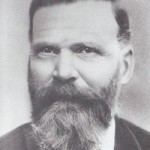John Rowley
(1841 –1893)
John Rowley was born July 14, 1841 in Suckley, England. On May 4, 1856, a board the ship Thorton, John, his mother, three brothers and three sisters set sail for America in the port of Liverpool. His father had died in 1848.
They arrived in New York on June 14, 1856. By rail they commuted to Iowa City, arriving there on June 26. On July 15 he was one of the 500 souls making up Captain Willie’s handcart company headed for Salt Lake City. Not until November 9 did they arrive in that city. John was not able to travel farther because of frozen limbs which needed to be cared for. His mother was counseled to take the rest of her family to Nephi, Juab County, Utah. John joined his mother there as soon as he recovered and there they established their first home in America.
John was the oldest child and took the responsibility of helping his mother with the family. He was not only progressive but had talents which so became a pioneer: the “know-how” and ability to subdue the earth.
In 1859, he married Frances Banks. Two children were born to them, John William and Frances Rosetta. Both children died. Later they were divorced. On September 10, 1864, he married Mary Ann Gadd to them were born 12 children.
On April 21, 1873, John married his first polygamous wife, Emma James Johnson, a widow having seven children. To them were born to children. On October 25, 1875, he married Emma Ozella Johnson. They had six children. Two years later, on April 10, 1877 he married her sister, Orissa Jane Johnson. They became the parents of seven children.
Besides having built homes for his family he had also built and was operating a sawmill at the mouth of Salt Creek Canyon which was the first sawmill near Nephi. About four years later, he purchased 160 acres of land on which he built lovely homes for the families. He had to develop a system of irrigation for his land. After getting water to the land he developed a new project for which use the water. He built a reservoir in which to store water to create power for a plaster of paris mill. Next, he built a large mill in the large waterwheel that stood 30 feet in the air. He constructed a wooden flume 12 inches square and 100 yards long that stood 20 feet in the air. By running water through the flume over the huge waterwheel he created the power to crush to powder the gypsum rock that he hauled from a hill nearby. After cooking the powder in a large boiler, it became a finished product of plaster of paris which was shipped to Salt Lake City. He donated hundreds of dollars worth of the plaster to the Church to be used in the building of the temple. The wastewater from the mill was used to water crops in the field.
He invented a machine and obtained a patent on it. This he used to make cement pipes to carry water to his home. He tunneled into the mountain to get the water. A little later he made and laid cement pipes to carry water from Salt Creek to the town of Nephi, thus creating the first water system for that town. He built, owned and operated his own gristmill. For all these projects he operated his own carpenter and blacksmith shops.
In October 1884 he was called to labor as a missionary in Great Britain. Upon his return, he married Belinda Kendrick on July 28, 1886. At that time persecution of the Church, because of the practices polygamy, was very strong. John was advised to move his families to Mexico.
In the spring of 1888, he started on the trail to Mexico with three of his wives, Ozella, Orissa (with their children), and Belinda. When they reached Pima, Arizona, he decided it was necessary to remain there a while and work. So he set up a blacksmith shop and repaired wagons for freighters. There they spent the winter. The following year, in November, 1889, after a long, hard trip they arrived in Colonia Diaz. In the year 1890, John returned to Nephi to sell his property and move his wife, Mary Ann, and children to Mexico. He bought three wagons and about 30 head of cattle that his sons Jesse and Heber drove. They arrived in Central, Arizona, in the fall. There he left Mary Ann and the children, except Heber, who helped move the stock on into Mexico. Again, in the spring of 1891, he returned to Arizona to get the rest of his family. They arrived in Colonia Diaz in September of that year. There he purchased a 12-acre farm and built two homes, one for Mary Ann and one for Belinda. To this couple were born three children. There he also built a flour mill and molasses mill.
He suddenly fell ill with pneumonia, and passed away on October 7, 1893 at Pacheco. 27 children mourned his death; five had preceded him.
Ellen Farnsworth, granddaughter
Stalwarts South of the Border compiled by Nelle Spilsbury Hatch page 598
http://www.findagrave.com/cgi-bin/fg.cgi?page=gr&GRid=57713831

